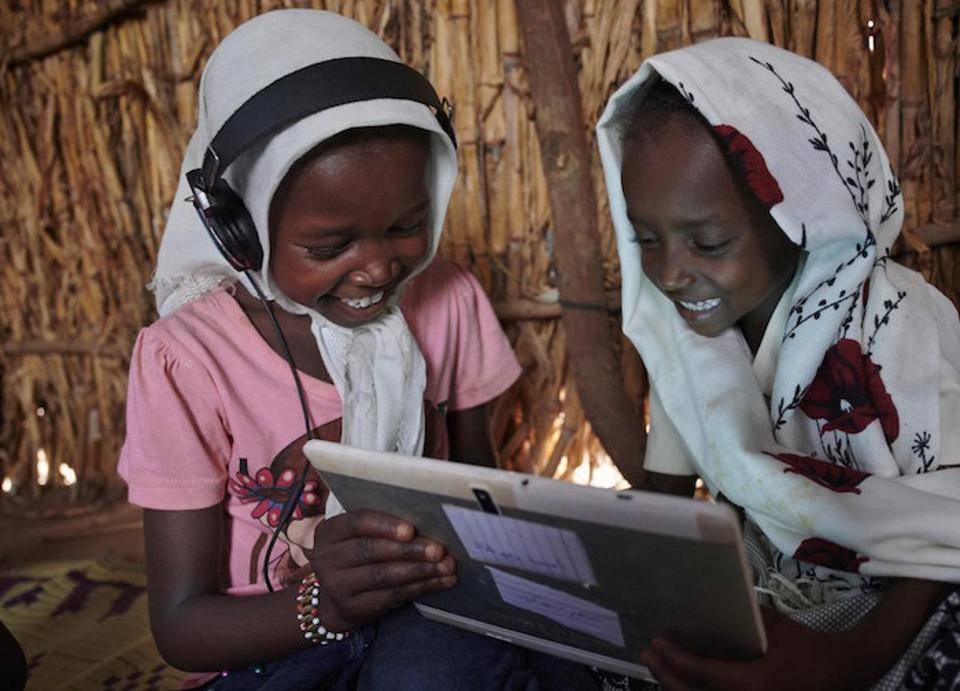
Children work together, using their tablet, at the UNICEF supported Debate e-Learning Center in a village on the outskirts of Kassala, the capital of the state of Kassala in Eastern Sudan.
© UNICEF/UNI322862/Noorani
The COVID-19 pandemic has been the largest disruptor of education in history, exposing widening inequalities.
When schools shut down around the world, many switched to remote instruction. And yet one-third of students — at least 463 million globally, according to a new UNICEF report — were unable to access it.
UNICEF got to work, keeping children learning through TV, radio and other innovative delivery methods. The flexibility and interactivity of online instruction makes it the more popular alternative to in-person classes, but it requires internet access. And far too many students lack that connectivity.
Closing the digital divide requires global cooperation, leadership and innovation
Even before the appearance of COVID-19, UNICEF recognized the need to address digital exclusion among vulnerable children and youth.
In 2019, UNICEF and partner ITU (the International Telecommunication Union, a United Nations agency) launched Giga, a global initiative to connect every school in the world to the internet and every student to information, opportunity and choice by 2030.
“Half of humanity still does not have access to the internet. Billions of people are missing out on the wealth of knowledge and information that — increasingly — can only be found online,” UNICEF Executive Director Henrietta Fore noted at the time Giga launched. “More than 360 million young people are excluded from the digital age by poverty, geography or other circumstances beyond their control.”
As a result, they have fewer resources to learn and to grow and limited opportunities to reach their full potential.

“I can still connect with my teachers while learning at home,” says Joaquin, 8, in Jayapura, Indonesia. “If I have difficulty with the assignments, I can reach out to them and ask for help.”
© UNICEF/UNI347236/Sumule
Mapping schools worldwide to assess demand and infrastructure
Working in partnership with governments, Giga is mapping the connectivity demand, using schools as a base point, and identifying where there are connectivity gaps. This information, combined with existing ITU mapping data, allows countries to take stock of their existing infrastructure and assess appropriate solutions for connecting schools. More than 800,000 schools in 30 countries have been mapped through Project Connect, a mapping and connectivity monitoring platform.
In partnership with industry, Giga will advise on the best possible technical solutions to provide schools with connectivity, and countries with safe, secure, reliable, fit-for-purpose infrastructure to support future digital development needs. Giga works with governments and advises them on building affordable and sustainable country-specific models for finance and delivery, subsidizing market creation costs and incentivizing private sector investment.
Picking up the pace of connectivity in Central Asia, the Eastern Caribbean and Sub-Saharan Africa
Below, an update on Giga’s recent progress in three regions:
- Central Asia: The mapping of all 2,180 public schools in Kyrgyszstan helped the government connect the remaining 690 unconnected public schools. Information from the project allowed the government to renegotiate its contracts, getting a 50 percent lower rate per Gigabyte for its schools — a savings of $200,000 per year. The first financial model in the region is being developed in Kazakhstan, where Giga has integrated 10,200 schools into its global mapping platform.
- Eastern Caribbean: Nine out of ten countries in the Eastern Caribbean states (OECS) have completed mapping of their schools. In partnership with OECS, Giga will enhance school connectivity and develop digital public goods to support the new digital education program for children in the region.
- Sub-Saharan Africa: Giga is working with the governments of Rwanda, Kenya, Sierra Leone and Uganda to map school connectivity and develop business models to make connectivity affordable and sustainable. Giga and the Directorate of Science, Technology and Innovation of Sierra Leone are working toward connecting 10,900 more schools, ensuring the education of 2.6 million learners.
Meaningful connectivity will fast track young people’s access to educational resources and opportunities
For UNICEF and its partners, COVID-19 makes it clearer than ever that reliable access to the internet should be a universal human right. And the Giga initiative for connecting children and young people to the internet shows tremendous potential for return on investment:
- $2.1 billion can connect 150,000 schools in 11 high-impact countries in the next year to reach an estimated 40 million children and young people
- $8 billion can connect 500,000 schools over the next two years to reach an estimated 100 million children and young people
“Digital technologies can dramatically improve the lives of people and communities and deliver on the promise of the United Nations Agenda 2030 to leave no one behind,” says Doreen Bogdan-Martin, Director of ITU’s Telecommunication Development Bureau. “Multi-stakeholder collaboration and partnership will be key to connecting the 3.6 billion people still off-line. We all have to work together and increase our efforts to bring technology to the people, in every area and every walk of life.”